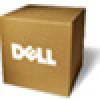Dell PowerConnect Brocade M6505 Hardware Reference Manual - Page 15
Software features
 |
View all Dell PowerConnect Brocade M6505 manuals
Add to My Manuals
Save this manual to your list of manuals |
Page 15 highlights
Software features 1 Software features The Brocade M6505 16 Gbps Fibre Channel SAN I/O Module supports the following software features. For updates to the supported feature set, refer to the Brocade Fabric OS Administrator's Guide and product release notes for additional information. • Access Gateway (AG) mode and Native Fabric mode. (Refer to "Access Gateway and Native Fabric modes" on page 5.) The SAN I/O Module ships in Access Gateway mode, but it can support the standard Native Fabric (Switch) mode. For detailed information about AG, refer to the Brocade Access Gateway Administrator's Guide. • Brocade Fabric OS (FOS), which delivers distributed intelligence throughout the network and enables a wide range of value-added applications, such as Brocade Advanced Web Tools and Brocade Advanced Fabric Services (on certain models) • Dynamic Ports on Demand (DPOD) offering the flexibility to scale from 12 ports on the Base model up to 24 ports • Inter-Switch Link (ISL) Trunking (licensable), which allows up to eight ports (at 16, 8, or 4 Gbps speeds) to combine to form a single, logical ISL with a speed of up to 128 Gbps (each direction, full duplex) for optimal bandwidth utilization, automatic path failover, and load balancing. • Enhanced Group Management, which enables the SAN I/O Module to be managed as a group • Detection and resolution of duplicate WWNs • Dell DMC, iDRAC, and CMC management • Dual and redundant firmware images • Service levels Class 2, Class 3, and Class F (inter-switch frames) • Role-Based Access Control (RBAC) for managing user-permission levels • Advanced zoning, which enables you to partition your storage area network (SAN) into logical groups of devices that can access each other • Zoning enhancements that allow a switch with the default zone "no access" to merge with a fabric • Buffer credit loss detection and automatic recovery on 16 Gbps ISLs • Importing and exporting of configuration information, including port speeds and zoning information • Port mirroring to monitor ingress or egress traffic from any port within the switch • SNMP v1, v2c, and v3. (SNMP traps log errors and alarms; logs can be exported) • TACACS+ and RADIUS remote authentication for switch management access • IPv4 support • AG enhancements, such as detection of unreliable N_Port links, RADIUS and LDAP support, Advanced Performance Monitoring (APM) capability, and F_Port static mapping • Forward error correction (FEC), which provides method error control during data transmission by sending redundant data to ensure error-free transmission on a specified port or port range (enabled by default) • IP address filtering for management access by way of Telnet, HTTP, HTTPS/SSL, SSH v2, and SNMP Brocade M6505 16 Gbps Fibre Channel SAN I/O Module Hardware Reference Manual 3 53-1002576-02















